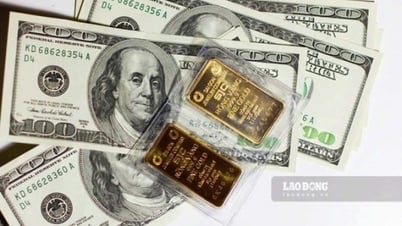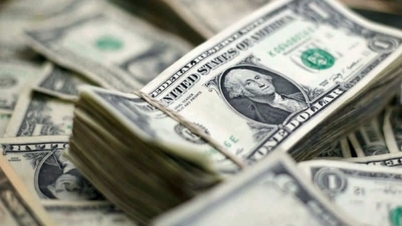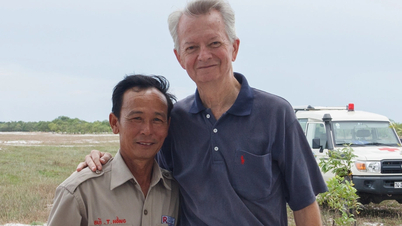Nearly 25,000 VND on the "black market"
In the early days of January 2024, the USD “heated up” significantly. By January 16, the USD/VND exchange rate skyrocketed in all markets, especially the greenback nearly reached 25,000 VND on the “black market”.
At the Joint Stock Commercial Bank for Foreign Trade of Vietnam (Vietcombank), the USD/VND exchange rate is traded at: 24,330 VND/USD - 24,670 VND/USD, up 35 VND/USD, equivalent to 0.14% in both buying and selling directions compared to the end of yesterday.
Joint Stock Commercial Bank for Investment and Development of Vietnam (BIDV) listed the USD/VND exchange rate at: 24,360 VND/USD - 24,660 VND/USD, an increase of 40 VND/USD in both buying and selling directions.
Vietnam Joint Stock Commercial Bank for Industry and Trade (VietinBank) adjusted the USD price up 69 VND/USD for buying but down 11 VND/USD, reaching 24,329 VND/USD - 24,669 VND/USD.

The USD/VND exchange rate skyrocketed across all markets, especially the greenback nearly reached 25,000 VND on the "black market". Illustrative photo
The exchange rates at Vietnam Technological and Commercial Joint Stock Bank (Techcombank) and Vietnam Prosperity Joint Stock Commercial Bank are listed at 24,353 VND/USD - 24,663 VND/USD, up 35 VND/USD and 24,330 VND/USD - 24,690 VND/USD, up 9 VND/USD for buying.
In the free market, the USD is approaching the 25,000 VND/USD mark. At Hang Bac and Ha Trung - the "foreign currency streets" of Hanoi, the USD/VND exchange rate is commonly traded at: 24,830 VND/USD -24,930 VND/USD, an increase of 40 VND/USD compared to the end of yesterday. At different stores, the difference can be 10 VND/USD.
Talking to reporters of the Journalists and Public Opinion newspaper, Dr. Nguyen Tri Hieu, a banking and finance expert, said that the USD/VND exchange rate is heating up due to the impact of both internal and external factors.
Firstly, in the month before Lunar New Year, businesses need a lot of dollars to import and pay for goods imported from abroad. Besides, the domestic economy has not shown positive signs in the first month of 2024. Therefore, the dollar price is being pushed up.
Second, according to Dr. Nguyen Tri Hieu, the US Federal Reserve (FED) still maintains its stance of maintaining high interest rates to fight inflation in the US. Currently, inflation in the world's largest economy is still higher than 2%, higher than managers' expectations. Therefore, interest rate cuts can only happen in mid-2024.
In addition, currently, with all the geopolitical fluctuations in Ukraine, the Middle East, etc., it has, is and will impact the world's financial situation, especially gold and the dollar.
All of these factors combined to push the USD higher.
USD cools down in Asian markets
The dollar cooled on Tuesday. The yen weakened slightly to 145.89 per dollar after data showed Japan's wholesale inflation was unchanged in December from a year earlier, slowing for the 12th straight month.
The data suggests the surge in consumer inflation will ease in the coming months and put pressure on the Bank of Japan (BOJ) to soon remove its massive stimulus package.
Expectations of a policy change from the BOJ strengthened the yen in late 2023, with the currency gaining 5% against the dollar in December. It has since fallen sharply, down 3% so far in January.
Investors had been scaling back expectations of an early rate cut from the Fed at the start of the year but data last week showing US producer prices unexpectedly fell in December reinforced views that a cut could come as soon as March.
Markets are now pricing in a 70% chance of a 25 basis point (bps) cut in March, up from 63% a week ago, according to the CME FedWatch tool. Traders are back to predicting a 160 basis point cut this year, up from 140 basis points last week.
However, most analysts say expectations are too high.
Against a basket of currencies, the dollar rose 0.234% to 102.88 after gaining 0.2% overnight in quiet trade due to a U.S. holiday on Monday.
A data-packed week awaits, with reports on China's fourth-quarter growth, UK inflation and US retail sales all scheduled for Wednesday.
Investors will also be focused on comments from central bank officials, including Federal Reserve Chairman Christopher Waller, whose dovish tone in late November helped fuel a market rally that ended the year with a bang. Waller is due to speak later Tuesday.
Meanwhile, the pound fell to $1.2687, down 0.30% on the day, off a near five-month high of $1.2825 against the dollar hit in late December. Elsewhere, the Australian dollar fell 0.43% to $0.6632, while the New Zealand dollar fell 0.39% to $0.6176.
Source




![[Photo] General Secretary concludes visit to Azerbaijan, departs for visit to Russian Federation](https://vphoto.vietnam.vn/thumb/1200x675/vietnam/resource/IMAGE/2025/5/8/7a135ad280314b66917ad278ce0e26fa)


![[Photo] General Secretary To Lam receives leaders of typical Azerbaijani businesses](https://vphoto.vietnam.vn/thumb/1200x675/vietnam/resource/IMAGE/2025/5/8/998af6f177a044b4be0bfbc4858c7fd9)



























































![[Photo] Prime Minister Pham Minh Chinh talks on the phone with Singaporean Prime Minister Lawrence Wong](https://vphoto.vietnam.vn/thumb/402x226/vietnam/resource/IMAGE/2025/5/8/e2eab082d9bc4fc4a360b28fa0ab94de)

































Comment (0)